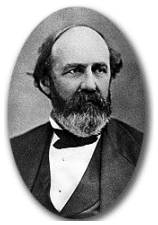

Collis Potter Huntington
Born: Harwinton, Connecticut
Place: October 22, 1821
Died: Lake Raquette, New York
Place: August 13, 1900
 Collis Potter Huntington was born in Harwinton, Connecticut on October 22, 1821. His family had little money, and he grew up helping out on his father's farm. As he grew into his early teens, he did farm chores and odd jobs for neighbors, too, and he began to save some of his earnings. He used these small savings to buy and sell small items, and by the time he was 16 years old he had received $3000 in credit form a New York bank. He invested the $3000 in clocks, and he began traveling and peddling his goods. He paid off his obligation to the bank, and kept building his profits. In 1842 he and his brother established a business in Oneonta, New York, selling general merchandise. Their business was successful.
Collis Potter Huntington was born in Harwinton, Connecticut on October 22, 1821. His family had little money, and he grew up helping out on his father's farm. As he grew into his early teens, he did farm chores and odd jobs for neighbors, too, and he began to save some of his earnings. He used these small savings to buy and sell small items, and by the time he was 16 years old he had received $3000 in credit form a New York bank. He invested the $3000 in clocks, and he began traveling and peddling his goods. He paid off his obligation to the bank, and kept building his profits. In 1842 he and his brother established a business in Oneonta, New York, selling general merchandise. Their business was successful.
When he saw opportunity blooming in America's West, he set out for California, and established himself as a merchant in Sacramento at the start of California's Gold Rush. Huntington succeeded in his California business, too, and it was here that he teamed up with Mark Hopkins selling miners' supplies and other hardware. He was becoming a wealthy man. In the late 1850's, he and Hopkins joined forces with two other successful businessmen, Leland Stanford and Charles Crocker, to pursue the idea of creating a rail line that would connect the America's East and West. In 1861, these four businessmen (sometimes referred to as The Big Four) pooled their resources and business acumen, and formed the Central Pacific Railroad company to create the western link of America's transcontinental railway system. Their task was huge, but these four men were up to the challenge, and they overcame obstacles with mountains, politics, surveys, financing, legislation, labor, and materials to see their idea transform into reality. The actual construction of the railroad began in 1863. On May 10, 1869, at Promontory, Utah, the tracks of the Central Pacific Railroad joined with the tracks of the Union Pacific, and America had a transcontinental railroad.
Collis Potter Huntington and his partners completed other rail projects, too, and The Big Four all achieved wealth and status as railroad magnates. In 1865 they formed the Southern Pacific Railroad company, and created rail lines from New Orleans to the Southwest and into California. The Southern Pacific system grew to more than 9,000 miles of track, with an additional 5,000 miles of steamship lines as a complement. In 1869 C.P. Huntington acquired the Chesapeake and Ohio Railroad, upgraded it and linked it to the Southern Pacific system. His backing built up Newport News, Virginia, linking it via the extended Ohio and Chesapeake system to the Southern Pacific, which extended in the West to San Francisco. In 1890, Huntington became president of Southern Pacific.
Estimates of Collis Potter Huntington's massive fortune put his worth at 35 million dollars, and he was one of the country's largest landholders. He acquired a substantial collection of art, and was generally recognized as one of the country's foremost art collectors. He left most of his collection, valued at some 3 million dollars, to the New York Metropolitan Museum. Collis Potter Huntington died at his camp, Pine Knot, in the Adirondacks on August 13, 1900.
Read more about Collis Potter Huntington and the creation of America's transcontinental rail system by clicking on one of these recommended books available through Amazon.com. A highly recommended biography is
The Great Persuader, by David Seivert Lavender. This is the best biography you will find on Huntington. If you are interested in the creation of the transcontinental railroad, purchase
Empire Express: Building the First Transcontinental Railroad, by David Haward Bain. It is a very comprehensive account of the building of the transcontinental railroad, packed with well-researched accounts and photographs.
|




